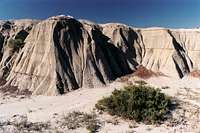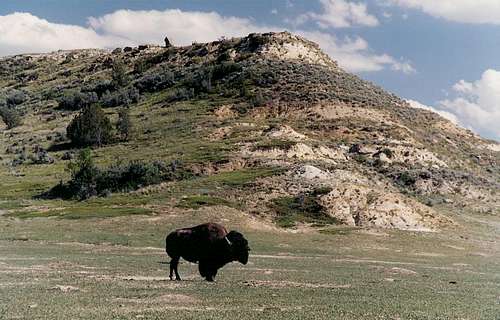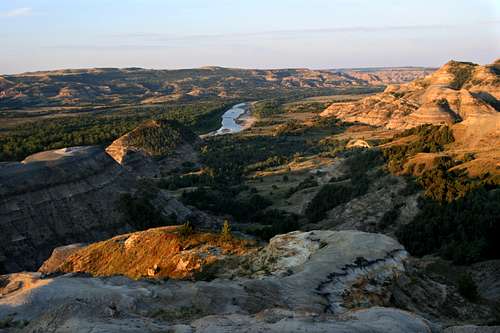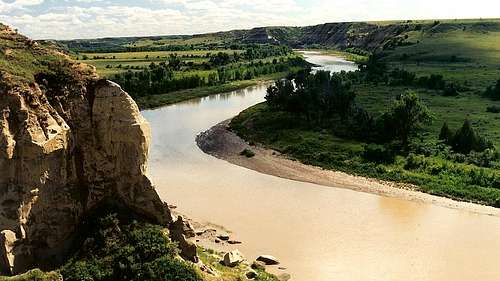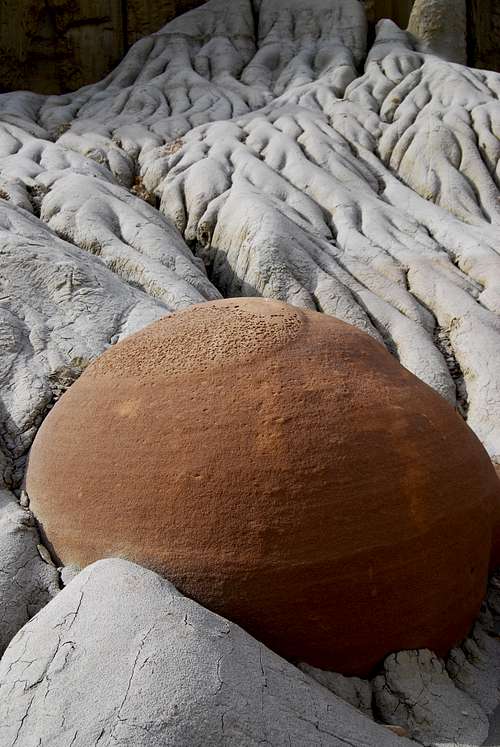-
 24491 Hits
24491 Hits
-
 96.75% Score
96.75% Score
-
 62 Votes
62 Votes
|
|
Area/Range |
|---|---|
|
|
46.93151°N / 103.48526°W |
|
|
Hiking, Scrambling |
|
|
Spring, Summer, Fall, Winter |
|
|
2600 ft / 792 m |
|
|
Overview
"I never would have been President if it had not been for my experiences in North Dakota." --Theodore Roosevelt
An 1883 hunting trip brought Roosevelt, just 24, to the North Dakota badlands, then part of the Dakota Territory, for the first time. Amazed by the scenery and the wildlife inhabiting it, he fell in love with the area. He so loved the area that he bought into one ranch and owned another outright. One, the Elkhorn Ranch, still exists as a detached unit of the national park and is accessible by 4wd roads that can become too muddy or washed out to be passable. The other, the Maltese Cross Ranch, once moved all the way to Oregon (it always was a bit of a rambler-- groan) but is now by the visitors center in the park's South Unit.
Roosevelt only spent a few years visiting North Dakota and never lived there full-time, but his times there affected him for the rest of his life and contributed to the values that made him probably the greatest conservationist president the U.S. has ever had. It was Roosevelt who famously said of the Grand Canyon, and implicitly of all wilderness areas, "Leave it as it is. You cannot improve upon it. The ages have been at work on it, and man can only mar it. What you can do is to keep it for your children, your children's children, and for all who come after you, as the one great sight which every American...should see"; one might say it is the Grand Canyon that should be named for Roosevelt, especially since it was he who declared it a national monument, but it is more appropriate that his name graces the North Dakota badlands since they were the seeds of a conservationist vision that has immeasurably enriched this nation.
Today's die-hard environmentalists would have mixed feelings about Roosevelt; after all, he probably shot more animals than some of those environmentalists have avoided eating. He was more the Hemingway type of outdoorsman (though perhaps it would be more correct to say Hemingway was a Roosevelt type) than he was the type who climbs up a redwood tree to protest its being cut down; he took from the land, but he also loved the land and respected it and its inhabitants-- a view similar to, though less pure than, that of the Native Americans, especially those, fittingly, of the Plains culture, whose existence depended upon hunting and killing the bison but who revered it at the same time and paid homage to its spirit. That ethic lives on, although it is far less unadulterated now, in all who feel a pull to and bond with the true wilderness, in those who value want less and need more, for they are not the same.
Let us also not forget that Roosevelt was the product of a different time. Hunting is on the wane today in industrialized nations, but it was still a rite of passage for many men a century ago. In fact, it is important to note that many of America's early explorers, frontiersman, and, yes, mountaineers were men who lived by the bounty of the land, not the bounty of the grocer. For his day, then, Roosevelt was remarkable for his views about conservation and stewardship of the land.
There is much myth surrounding Theodore Roosevelt, and he was certainly a man with his share of flaws. Nevertheless, those who love the wild owe him a debt of gratitude for the conservationist legacy he left for all of us. Even today, his name is often invoked in discussion and debate of conservation and environmental issues; his is up there with names like John Muir, Aldo Leopold, and Edward Abbey as those of the great voices for, and protectors of, the wilderness. America owes him much more than a national park named for him, but it is fitting that the only national park named for a president is the one that honors him.
The Park
Overview
Established in 1978 when Jimmy Carter signed a law changing the area from a memorial park to a national park, Theodore Roosevelt National Park protects thousands of acres of badlands, or "breaks," and High Plains grasslands along and near the Little Missouri River. It is an epic Western landscape of colorful buttes, a meandering river, and endless skies. North Dakota is part of the "Big Sky Country" that encompasses the Northern Plains, and it doesn't take long once here to understand the term. One of the most beautiful things you will ever see is a huge thundercloud building over the flat landscape of the plains.
The park is divided into two noncontiguous units, North and South (plus the Elkhorn Ranch site). The North Unit is smaller and more remote, and thus less visited. The South Unit has a more extensive trail system and at times can seem crowded along the loop road that tours the unit, especially around the prairie dog towns alongside the road and when bison come into view. But this is one of the country's least-visited national parks, and it is easy to find relief from your fellow humans out here.
Wildlife
Wildlife abounds. The park is home to, among many other things, bison, prairie dogs, elk, golden eagles, and wild horses. There are not many places where you can run the risk of being trampled by a bison and bitten by a rattlesnake at the same time. Theodore Roosevelt National Park is one such place. And seeing a group of wild horses standing on a ridge above you can be a deeply moving experience.
Take extra care around the roadside prairie dog towns. These creatures are amusing and fascinating to watch and listen to, but they cross the road frequently and are pretty slow. Remember that the park is their home and that you are a visitor, so look out for them. Another thing to know about prairie dogs is that they are not pets; they can inflict nasty, painful bites and are known to carry diseases.
One of the dumbest things you can ever do is approach a bison. Bison usually mill about and look clumsy, but they can run almost as fast as a racehorse can, and they can trample and/or gore you. People have been maimed and killed by bison. Bison are wild animals, not domestic cattle.
Climate and Seasons
The park lies in a continental semiarid climate zone, with hot summers and cold winters. January is the coldest month, with average highs and lows of around 30 and 0, respectively, and snowfall totals averaging around 6 inches on average; the record low was -49, in 1950. July is the hottest month, with an average high of 87 and a low of about 55. High temperatures above 90 are common in summer, though, and temperatures sometimes break 100; the record high temperature was 110, in 1981. Thunderstorms are common on summer afternoons, and they can turn the ground into an impassable gumbo.
The best seasons to visit are late spring and early fall, but most non-locals are going to visit in the summer, and they should prepare themselves for desert-like conditions.
What To Do
The park has several trails ranging from short nature trails to excursions deep into the backcountry. The park is also a wonderful place for wandering; although it is not hard to find solitude away from the car here, it is even easier to find it if you are willing to equip yourself properly and go wandering the among the canyons and along the ridges.Almost all the trails are in the North and South Units, though one trail, the Maah Daah Hey Trail (96 miles) crosses both units as well as other badlands and plains terrain outside the park on federal, state, and private lands.
Also, the park is only about an hour's drive away from spectacular Makoshika State Park in Montana. Consider visiting both places while you are out here.
In the External Links section there is a link to an excellent website providing information about the park's trails. What follows here is a brief discussion of a few I personally consider to be among the best.
North Unit
Caprock Coulee-- By combining this trail with the Upper Caprock Coulee Trail, you can make a trip of up to 4.5 miles through a landscape of buttes, hoodoos, and mushroom-like caprocks. Part of the trail is a self-guiding nature trail.
South Unit
Coal Vein-- For almost 30 years, ending in 1977, a coal seam here burned, and the heat altered the immediate landscape, affecting both the rock (well, the clay and sand) and the vegetation. This is an easy trail a little less than a mile in length.
Jones Creek-- With a vehicle shuttle, this is a great way to slip away into the badlands for a couple hours; it has two ends, both along the unit's scenic drive. This 3.7-mile trail is mostly level and passes through a butte-filled landscape. There are some creek crossings, but the crossings are usually dry. After a storm or during snowmelt, though, the crossings can be difficult or dangerous.
Petrified Forest-- This trail, one of the longer ones in the park, leads to a remote area with the park's greatest concentration of petrified wood (illegal to remove). There are two trailheads. From the eastern TH, which is along the park road, RT distance is about 15 miles. From the western TH, RT distance is close to 11 miles, but access is via an unpaved road that can be impassable in wet conditions.
Wind Canyon-- This short trail (one mile RT) leads to a spectacular viewpoint high over the Little Missouri River. There are also some interesting rock formations here.
[img:492237:aligncenter:medium:Photo by distressbark]
Getting There
Most visitation occurs in the South Unit, easily accessed from the Medora exit on I-94 about 25 miles east of the MT-ND border. I-94 is actually the southern boundary of the South Unit for several miles.Many people get a glimpse of the park from the Painted Canyon Visitor Center, which is right off the interstate about 10 miles east of Medora. Here, there is a fine view across the badlands of the South Unit, and all most people do here is take in the view and stop to use the facilities, but there is access to some hiking trails here.
The North Unit is off U.S. 85. Take Exit 42 off I-94 (the exit is about a5 miles east of Medora) and drive north for about an hour to the park entrance. Most people who approach from the north probably do some from the Williston area, which is also along U.S. 85 and about an hour's drive from the park entrance.
Red Tape; Camping and Lodging
Fees
The entrance fee of $10 provides one week of access. Annual passes are available ($20), as is the Interagency Pass ($80), which provides a year's worth of access to federal fee areas.
Camping
The North and South Units each have a campground (Juniper-- formerly Squaw Creek-- and Cottonwood, respectively). 2009 camping fees are $10 per night. Flush toilets and running water are available; hook-ups are not. These campgrounds are open all year, and sites are available on a first-come, first-served basis.
Backcountry camping is permitted with a free permit. Check the park website for regulations about backcountry camping.
Lodging
The town of Medora is just outside the entrance to the South Unit and has some hotels and restaurants.
External Links
NPS park websiteTheodore Roosevelt National Park Information Page-- This page has more detail than the NPS page does.
Park hiking and trail information
Park map


